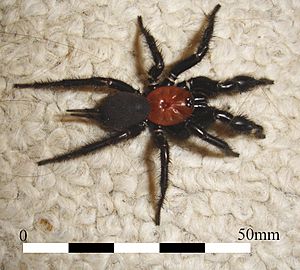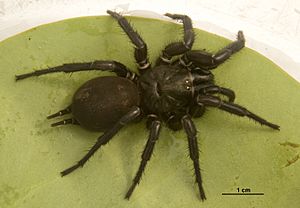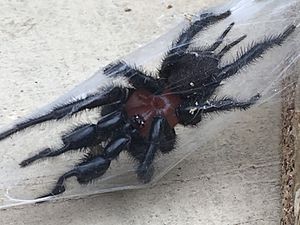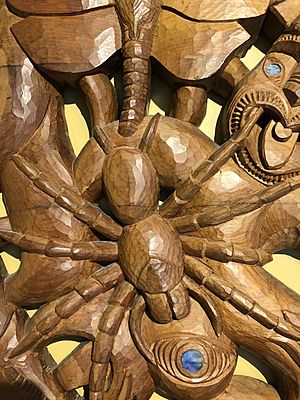Black tunnelweb spider facts for kids
Quick facts for kids Black tunnelweb spider |
|
|---|---|
 |
|
| Scientific classification | |
| Synonyms | |
|
Mygale antipodiana Walckenaer,1837 |
The black tunnelweb spider, known scientifically as Porrhothele antipodiana, is a type of spider. You can find it all over New Zealand and the Chatham Islands. It lives in forests and gardens. This spider is one of New Zealand's most studied spiders.
It is related to tarantulas. However, it is a harmless cousin of the dangerous Australian funnel-web spider.
Contents
Description
Female black tunnelweb spiders usually have a yellow or orange-black carapace (the top part of their body). Their legs and palps are often orange-brown, but darker than their body. Their chelicerae (mouthparts) are reddish-brown, sometimes black. The underside of their body (sternum) is a pale reddish-brown.
The abdomen (the back part of their body) is a solid purple-black color. Young spiders might have faint patterns on their abdomen. The openings of their two pairs of book lungs are ringed with cream. Females are bigger than males. They can grow to be over 30 millimeters (about 1.2 inches) long.
Male black tunnelweb spiders have a darker carapace than females. Their legs and palps are a dark reddish-brown. Their chelicerae are also dark reddish-brown or black. Their abdomen is colored much like the females'.
People often confuse Porrhothele antipodiana with spiders from the Hexathele group. Both types of spiders live in similar places and build similar webs. You can tell them apart by looking at their spinnerets. Porrhothele spiders have two sets of spinnerets, while Hexathele spiders have three.
As their name suggests, these spiders build long, tunnel-shaped webs. These webs are not sticky. They often build them under logs and rocks. They also make webs in tree trunks, rock faces, and even in city buildings. The tunnels can be up to 25 centimeters (10 inches) long and 3-4 centimeters (1.2-1.6 inches) wide. They usually have just one opening. Silk spreads out widely from this opening to catch prey and alert the spider. Spiders can spin these tunnel webs very quickly, sometimes in just one hour.
Spider Names and History
The black tunnelweb spider, Porrhothele antipodiana, was first described in 1837. A French scientist named Charles Athanase Walckenaer gave it the name Mygale antipodiana. This was one of the first times a spider species from New Zealand was described.
Over the years, other scientists found similar spiders and gave them different names. For example, in 1849, Adam White described two New Zealand spiders. He called them Mygale antipodium and Mygale hexops. Another scientist, Hippolyte Lucas, described Mygale quoyi in the same year.
Later, scientists realized that many of these different names were actually for the same spider. In 1892, Eugène Simon created a new group, or genus, called Porrhothele. He moved Mygale antipodiana into this new group, making its name Porrhothele antipodiana. He also figured out that some other named spiders, like Macrothele insignipes, were actually the same as Porrhothele antipodiana.
Scientists like Henry Hogg and Valerie Todd Davies continued to study these spiders. They helped confirm that many of the earlier described spiders were indeed the same species. In 1968, Raymond Forster gave an updated description of P. antipodiana. He also thought that there might be other very similar Porrhothele species that look alike but are actually different.
Where They Live
Porrhothele antipodiana is the most common type of Porrhothele spider. You can find it all over both the North and South Islands of New Zealand. In the North Island, it doesn't seem to live in the Northland area. Another spider, Porrhothele quadrigyna, lives there instead. In the South Island, it lives almost everywhere except the high mountains.
These spiders also live on the Chatham Islands. Scientists think they were brought there by humans recently.
Black tunnelweb spiders live in many different places. They often hide under old logs and rocks. They also build webs in cliffs and rock faces. You can find them in forests, sand dunes, gardens, and on hillsides with lots of rocks.
Life Cycle
When a female spider lays her eggs, they are loosely held together in a silk cocoon. She builds these egg sacs from late October to mid-December, which is during the summer in New Zealand. A single egg sac can hold between 100 and 300 eggs.
The eggs usually hatch about 30 days after they are laid. The baby spiders, called spiderlings, are about 2-3 millimeters long when they hatch. A few days later, they shed their skin for the first time. The spiderlings stay in their mother's nest until they grow bigger. For the first five weeks, they are not very active. After their second skin-shedding, they become more active. They start spinning webs and looking for food. By the end of their first year, spiderlings can grow to about 12 millimeters (0.5 inches) long.
These spiders become adults after 2-3 years. Even as adults, they will continue to shed their skin sometimes. Porrhothele antipodiana spiders live a relatively long time, often for at least six years.
What They Eat
Like most spiders, Porrhothele antipodiana is a carnivore. This means it eats only meat. The remains of its meals are often scattered throughout its web. This makes it easy to see what the spider has been eating. These spiders seem to eat almost anything that gets close to their web. So, their diet often depends on what other creatures are in the area.
Some of the things P. antipodiana has been seen eating include woodlice (like Porcellio scaber), bumblebees, beetles (like Holcapsis and Xyloteles), and even other spiders (like Dolomedes).
One interesting prey item is the snail Cornu aspersum. These snails are not native to New Zealand. Snails are hard for most spiders to catch because they have a tough shell and can produce slime. When a P. antipodiana spider catches a snail, it first bites into the snail's soft body. The spider tries to keep its fangs in as the snail pulls back into its shell. The snail will produce a lot of foam to try and get rid of the spider. Even though the snail seems to be resistant to the spider's venom, it usually dies after about 30 minutes. The spider might then spend many hours eating the snail.
Another notable prey is the German wasp, Vespula germanica, which is also not native to New Zealand. These wasps are aggressive, so you might think they would be hard for a spider to catch safely. Once a wasp gets tangled in the web, the spider grabs it from behind its body (to avoid the stinger). Then, the spider kills the wasp.
Who Eats Them
The North Island brown kiwi is known to eat Porrhothele antipodiana spiders.
Parasites
Porrhothele antipodiana can be infected by a parasite called Aranimermis giganteus. This is a type of worm (nematode) that infects New Zealand's tarantula-like spiders. Spiders infected with this parasite seem to be drawn to water. They end up drowning, which allows the A. giganteus worm to complete its life cycle in water.
Interactions with Wasps
Spider-hunting wasps are a big danger to these spiders. Especially the wasp Priocnemis monachus. These wasps are experts at hunting large spiders. They sting and paralyze the spider. Then, they lay their eggs on the spider's body. When the eggs hatch, the baby wasps eat the spider.
When a wasp finds a spider's burrow, it goes inside and corners the spider. The spider will stand up in a defensive pose. But the wasp usually stings the spider many times during the fight, paralyzing it. Since the spider is much bigger than the wasp, the wasp has to drag it backward to its nest. Once the spider is in the nest, the wasp lays an egg on it. This egg eventually hatches and feeds on the spider.
Interactions with Mice
New Zealand has many animals that were brought there by humans, including mice. In their natural homes, black tunnelweb spiders might meet mice and other introduced animals. These animals could try to eat the spiders.
When P. antipodiana spiders were put in containers with mice, they took a defensive pose when the mice came near. The mice would attack with quick, darting movements, nipping at the spider's outstretched legs. The spider would try to bite the mice, but the mice usually avoided the bites. As the fight continued, the spider would get tired. If parts of its legs were torn off, body fluid would spill out, and the spider would die. The mice would then eat the spider's body.
However, sometimes the spiders managed to bite the mouse. This would make the mouse confused, shiver, and eventually die. Mice that survived a bite would later avoid attacking these spiders.
Interactions with Humans
Porrhothele antipodiana spiders might bite a human if they feel threatened. Since these spiders can live in gardens, it's possible for a person to accidentally encounter one and get bitten, though this is rare. Bites are painful. They might cause swelling, itching, or numbness in the area. A bite might leave two small marks on the skin.
There has only been one known case of serious symptoms from a bite. This was likely due to an infection that happened afterward. If you are bitten, it's a good idea to clean the area to prevent infection. The spider's venom is not dangerous to humans.
In Maori Culture
Some people think that the word "kahuwai" in Maori stories might refer to the Porrhothele antipodiana spider. "Kahuwai" is a word for an unidentified spider species in Maori literature.






